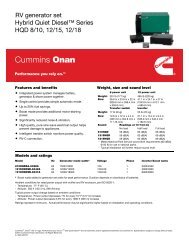Air Brake Manual
Air Brake Manual
Air Brake Manual
Create successful ePaper yourself
Turn your PDF publications into a flip-book with our unique Google optimized e-Paper software.
<strong>Air</strong>-actuated Hydraulic <strong>Brake</strong> System<br />
<strong>Air</strong> lines<br />
Foot valve<br />
<strong>Air</strong> brake<br />
chamber<br />
Hydraulic master<br />
cylinder<br />
Hydraulic lines<br />
Hydraulic wheel<br />
cylinders<br />
Hydraulic<br />
wheel<br />
cylinders<br />
Hydraulic master<br />
cylinder<br />
Compressor<br />
Reservoirs<br />
<strong>Air</strong> lines<br />
<strong>Air</strong> brake<br />
chamber<br />
It is essential that the operator of such a vehicle<br />
have knowledge of air pressure build up time,<br />
governor loading and unloading pressure, warning<br />
device operation, and how to drain air reservoirs<br />
properly (see Section Nine; Pre-Trip <strong>Air</strong> <strong>Brake</strong><br />
Inspection).<br />
If an air-actuated hydraulic brake system was to<br />
lose its air supply, the vehicle would have no service<br />
brakes. Only the parking brake would be operating<br />
as it is mechanical and requires no air pressure to<br />
operate.<br />
Each vehicle manufacturer may have different<br />
parking brake applications, either automatically<br />
when air pressure is reduced in the reservoir, or<br />
mechanically by a brake on the rear of the<br />
transmission, or with the rear brake system. Since<br />
hydraulic brake systems actuated by air pressure<br />
are regarded as an air brake system, your driver’s<br />
licence must have an air brake endorsement for you<br />
to operate vehicles equipped with air-activated<br />
hydraulic brakes.<br />
As there are many different systems in use, refer to<br />
the operator’s manual.<br />
<strong>Air</strong>-boost Hydraulic <strong>Brake</strong> System<br />
(<strong>Air</strong> <strong>Brake</strong> Endorsement not Required)<br />
An air-boost hydraulic brake system uses air<br />
pressure to assist brake force. This is similar to<br />
vacuum-assisted brakes on most passenger<br />
vehicles. An air-boost system usually has the same<br />
components of a standard air supply system<br />
including a compressor, governor, wet and dry<br />
reservoirs. These components are found usually in<br />
the same places as on a full air brake system. The<br />
brake pedal linkage operates a hydraulic master<br />
cylinder that sends hydraulic pressure to the<br />
booster unit. Initially, at low pressure the hydraulic<br />
fluid passes through the booster and begins to<br />
pressurize the wheel cylinders moving the brake<br />
shoes out to the drums. These booster units are<br />
similar in operation to “Hypower” or “Hydrovac”<br />
vacuum boosters found on most light and medium<br />
weight vehicles, but air pressure is used to intensify<br />
the hydraulic pressure generated by the master<br />
cylinder rather than vacuum. Built into the booster<br />
unit is a hydraulically operated air control valve.<br />
22




